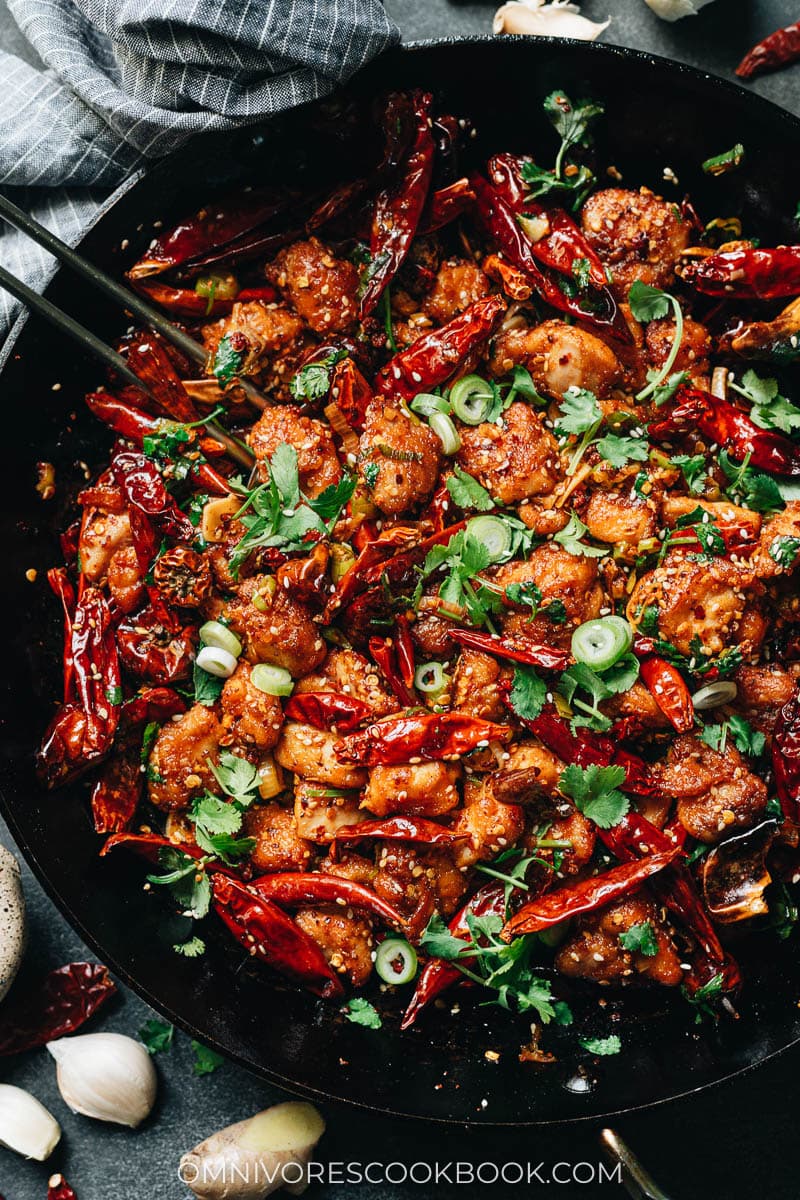
What is La Zi Ji
La Zi Ji is a signature Sichuan dish that is extremely popular in China. The chicken is coated with spices and flash fried until golden brown and crispy. It’s then stir fried with tons of dried chili peppers, Sichuan peppercorns, ginger and garlic to create a spicy numbing sensation. It is spicy yet you cannot stop eating it because it’s SO GOOD!
When introducing someone who’s new to Chinese food to the real deal La Zi Ji (辣子鸡), or Sichuan Mala Chicken, I’d describe the dish as “fried chicken covered in hot sauce” so it won’t completely scare them away.
During my years working in Beijing, I took every single foreign colleague to one of my favorite Sichuan restaurants, Yu Xiang Ren Jia (渝乡人家). Mala Chicken was one of the dishes that always appeared on our lunch table. Although my initial goal was to introduce genuine Sichuan food to the uninitiated, I confess that secretly I just loved my colleagues’ stunned faces on seeing the giant plate of chili peppers placed before them. After staring at the plate for a few moments, they would cautiously dig up a piece of hot chicken with suspicion written on their brow, fearful that it might burn a hole in their stomach.
And you know what? My guests always ended up loving this dish.
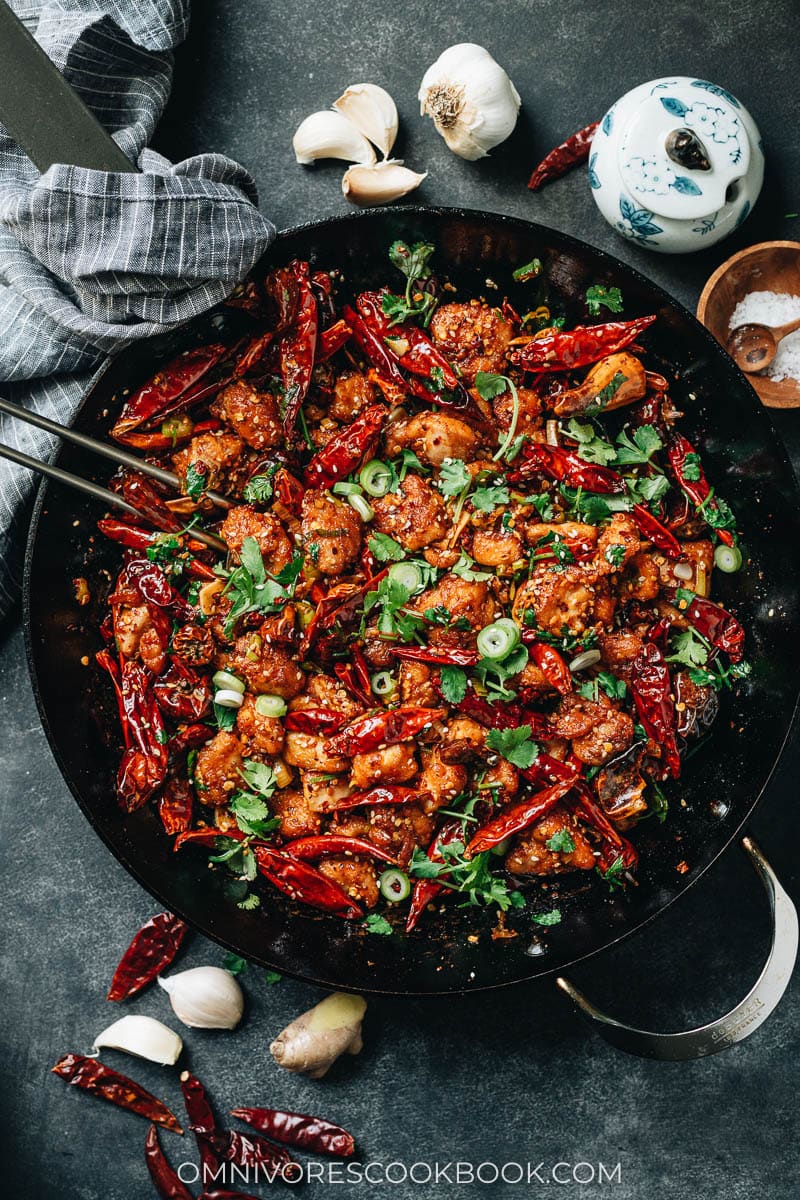
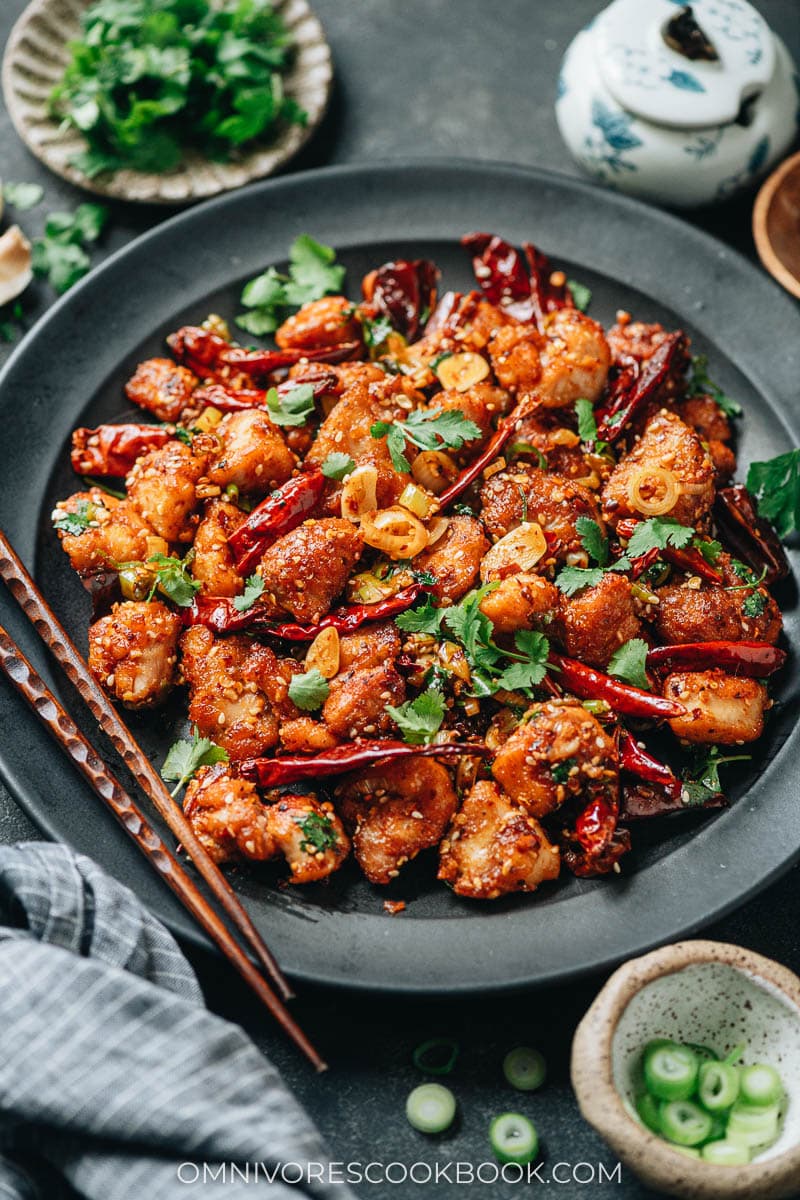
Authentic La Zi Ji
The flavor profile
La Zi Ji is spicy, but not as spicy as it looks. Sichuan cuisine pursues truly bold flavors that are well-balanced. In this chicken dish, the balance comes from the spiciness and smokiness of the chili peppers, the numbing tingling Sichuan peppercorns, the nuttiness of the sesame seeds, savory aromatics, salt, and a small amount of sugar. The dish offers a deep savory taste using heat as a medium. It is not like pure, tear-inducing Thai-style spiciness.
The presentation
Hiding the chicken under a mountain of peppers is just the authentic Sichuan way to display the food. The nutty, smoky fragrance of the vibrant peppers reaches your nostrils before your chopsticks do, and it makes your mouth water and makes you suddenly feel ten times hungrier.
Here are some fun facts about the authentic Mala Chicken we serve in China:
- Chinese chefs usually use tiny bone-in chicken pieces to cook this dish. It takes some effort to pick the meat from the bones, which makes eating it extra satisfying. But here we make things easy by using boneless thighs.
- The amount of chili peppers in the dish far exceeds the amount of chicken, so you’ll need to spend quite some time digging through the peppers in order to find a chunk of meat. I used a ton of peppers in the dish for the presentation, but feel free to reduce the amount because it doesn’t affect the flavor too much.
- Tons of numbing, tingling, whole Sichuan peppercorns are used. You need to keep a sharp eye and shake off these fiery little corns before placing a piece of chicken on your tongue, otherwise your tastebuds will completely shut down for the next 10 minutes. I included two methods in the recipe below, so you can either include or exclude the peppercorns.
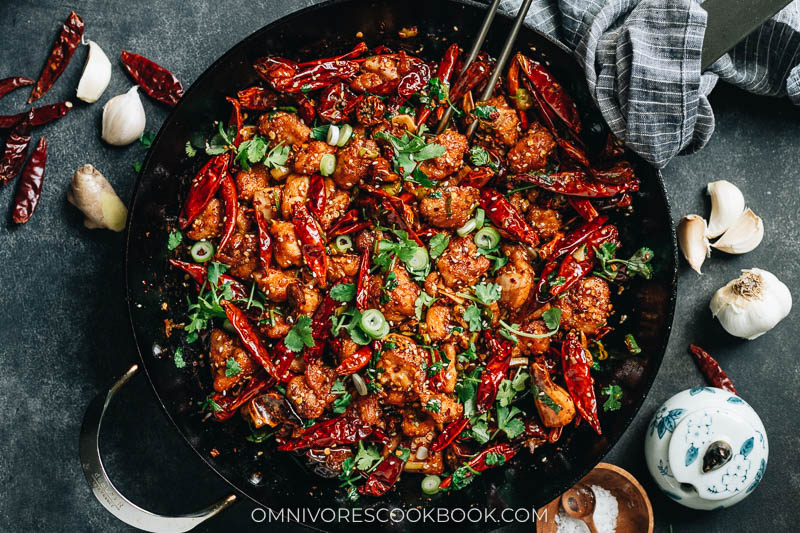
Key ingredients for La Zi Ji
To cook the real-deal La Zi Ji, Sichuan chili peppers and Sichuan peppercorns are the two irreplaceable key ingredients.
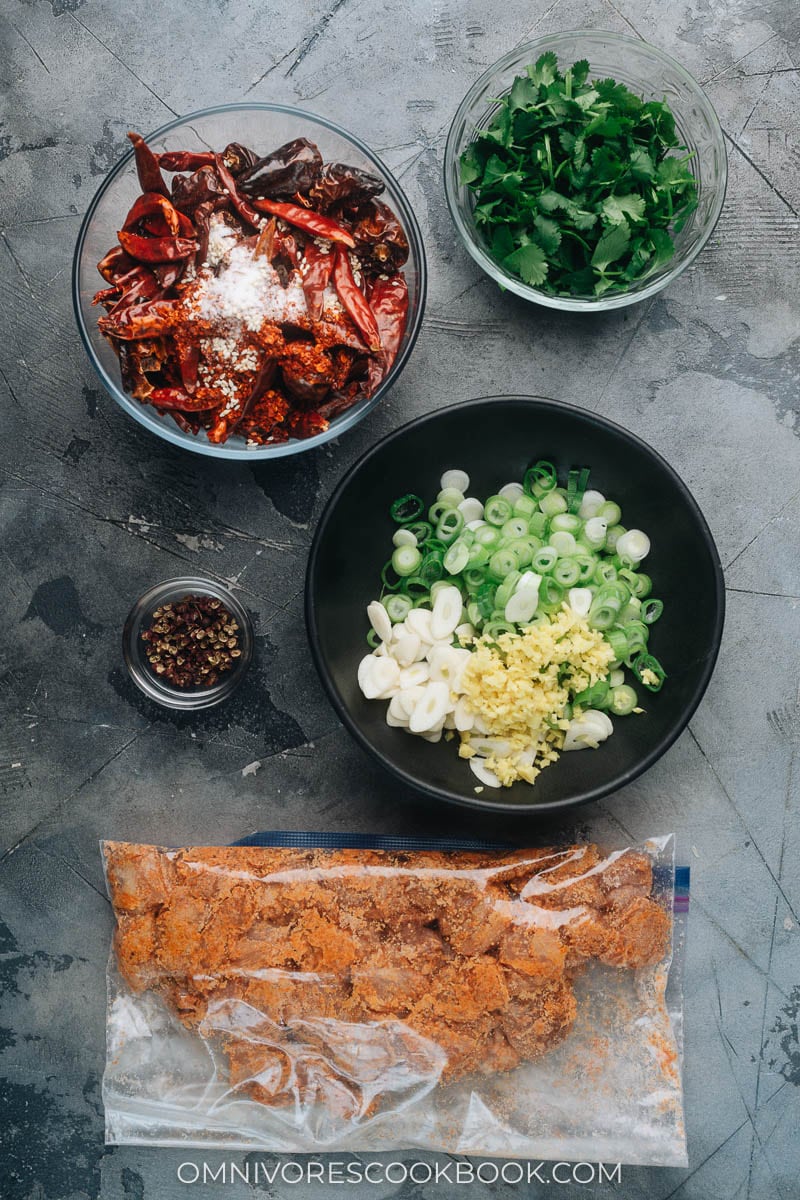
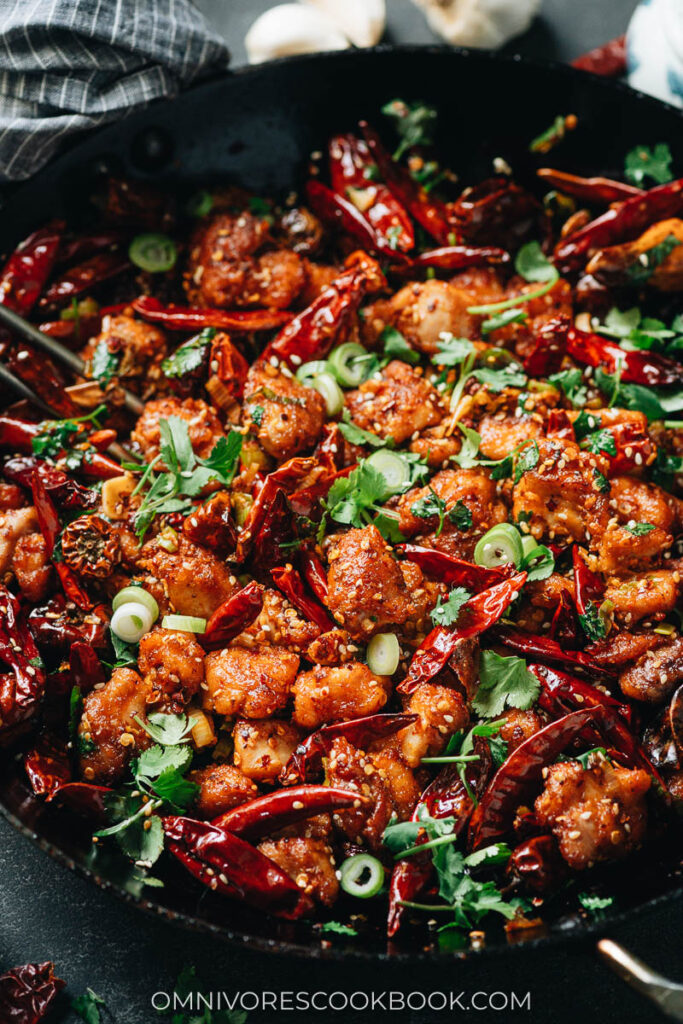
Sichuan dried chili pepper
There are a few types of Sichuan chili peppers that are commonly used in Sichuan cuisine.
In the recipe for La Zi Ji, chefs usually use medium heat Facing Heaven Chili (Chao Tian Jiao, 朝天椒). The short, fat Lantern Peppers (Deng Long Jiao, 灯笼椒) are often added for their nice smoky flavor. And you can control the heat level by leaving the peppers whole for a milder dish, or slicing them to expose the seeds for a much spicier dish.
Sichuan peppercorns
Sichuan peppercorn (Hua Jiao, 花椒) is another key ingredient that you might not be familiar with. Fresh Sichuan peppercorns have a pungent aroma that lingers around the nose. Its taste is almost indescribable: numbing, tingling, and somewhat refreshing like mint. These corns add a savory, smokey and slightly citrusy flavor to a dish, and that is what makes it genuine Sichuan food. I consider it even more important than Sichuan chili peppers, truly distinguishing the dish and giving it a character unlike anything else.
If you’re ready to cook up some authentic La Zi Ji or some other Sichuan dishes, order some premium Sichuan peppercorns and chili peppers now. You’ll be surprised how good your dish turns out simply by using fresher spices.
How to cook La Zi Ji
Cooking a great plate of La Zi Ji takes some extra steps, but it is totally worth the effort.
How to prep the chicken
To get the most flavorful chicken, you will need to
- Marinate the chicken with soy sauce and Shaoxing wine first to infuse the flavor.
- Coat the chicken with a dry coating: a mixture of cayenne pepper powder and ground Sichuan peppercorns along with cornstarch.
I found the coating really makes this dish stand out and taste much more flavorful than if you directly add the seasonings during the stir fry process.
For the dry coating, I prefer the ziplock method the most. Because the mixture is quite spicy, you can massage the spices into the chicken without burning your hand.
Mise en place
Once you start cooking, the process is super fast. So you will want to make sure your table has these ingredients prepped before you start the cooking: marinated chicken with the dry coating, chopped aromatics, Sichuan peppercorns, the dry mixture of chili pepper and other spices, and chopped cilantro.
Cooking process
- Spread out the chicken in the hot pan and fry it with minimal touching to ensure browning.
- Once the chicken is browned on both sides and cooked through, transfer it onto a plate.
- Stir fry the aromatics.
- Roast the dry spices and chili peppers to release the fragrance.
- Add the chicken back to the pan and toss it.
- Stir in the cilantro.
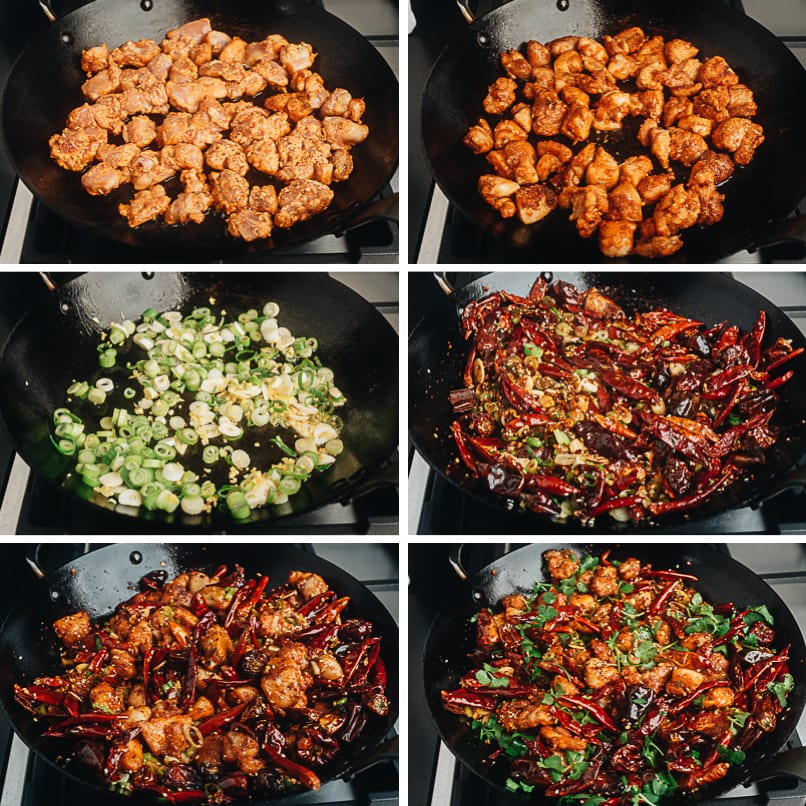
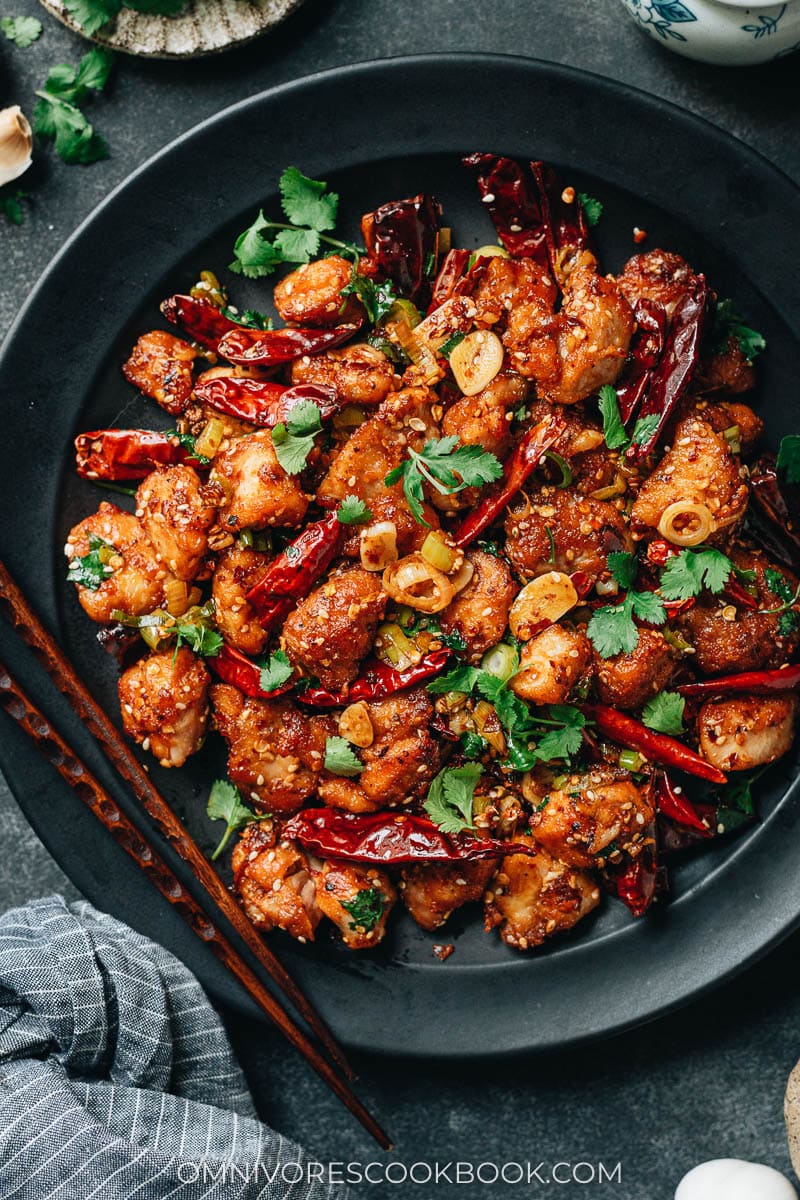
How to serve La Zi Ji
A bowl of steamed rice is the default side dish. I also highly recommend serving another cold appetizer or a light vegetable dish, so you have something to counterbalance the hot chicken.
Here are some great options for appetizers and side dishes:
- Chinese Pickled Cabbage (A Quick Pickle Recipe)
- Chinese Spinach and Peanut Salad
- Easy Chinese Cucumber Salad (拍黄瓜)
- Wood Ear Mushroom Salad (凉拌木耳)
- Five Spice and Garlic Roasted Potatoes
- Stir-Fried Pea Shoots with Garlic (蒜蓉炒豆苗)
- 4-Ingredient Baby Bok Choy Stir Fry
Other delicious Sichuan dishes
- Suan La Fen (Hot and Sour Noodle Soup, 酸辣粉)
- Ma La Xiang Guo (Sichuan Mala Dry Pot, 麻辣香锅)
- Shui Zhu Yu (Sichuan Boiled Fish, 水煮鱼)
- Fu Qi Fei Pian (Sichuan Sliced Beef in Chili Sauce, 夫妻肺片)
- Dan Dan Noodles (担担面)
- Authentic Mapo Tofu (麻婆豆腐)
Chinese Cooking Made Easy
Are you new to this website? This free email series is a great place to start. I’ll walk you through a few of my most popular recipes and show you how and why they work. You’ll quickly start to cook better Chinese food in your own kitchen.
Watch video
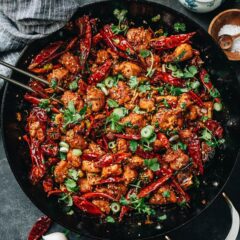
La Zi Ji (Sichuan Mala Chicken, 辣子鸡)
Ingredients
Marinade
- 1 lb boneless skinless chicken thigh (or breast) , cut into 1” (2.5 cm) cubes
- 1 tablespoon Shaoxing wine (or dry sherry)
- 1 tablespoon light soy sauce (or soy sauce)
Spice mix
- 1 tablespoon toasted sesame seeds , and more to garnish
- 1 to 3 cups whole dried red Sichuan chilies (*Footnote 1)
- 2 tablespoons Sichuan chili flakes
- 1 teaspoon sugar
Chicken coating
- 1/4 cup cornstarch
- 1 teaspoon cayenne powder (*Footnote 2)
- 1 teaspoon ground Sichuan peppercorns (*Footnote 3)
- 3/4 teaspoon salt
Cook
- 1/4 to 1/3 cup peanut oil (or vegetable oil)
- 2 teaspoons Sichuan peppercorns
- 5 garlic cloves , thinly sliced
- 1 thumb ginger , minced
- 4 green onions , sliced
- 1 cup chopped cilantro , and more for garnish
Instructions
- To marinate the chicken: Combine chicken pieces, Shaoxing wine, and soy sauce in a medium-sized bowl. Mix well and marinate for 10 to 15 minutes.
- For the spice mix: Combine all the spice mix ingredients in a big bowl.
- For the chicken coating: Mix cornstarch, cayenne powder, ground Sichuan peppercorns and salt in a large ziplock bag. Shake to mix well
- When you’re ready to cook, drain the chicken pieces and discard the marinating liquid. Transfer the chicken pieces into the bag with the cornstarch mixture. Shake the bag to coat the chicken, then use your hands to massage the bag so the spice is evenly mixed in. There should be little / no dried ingredients left in the bag. Massage the bag more if you still see a lot of uncoated cornstarch. On the other hand, if the chicken pieces look wet, sprinkle on a bit more cornstarch.
- To cook the stir fry: Heat a large skillet (or a wok) over medium-high heat until wisps of smoke start to rise. Add oil. (Or add oil in the pan and heat together if using a nonstick skillet.) When oil is hot, spread out the chicken pieces without overlapping them. Use a pair of tongs or chopsticks to separate the chicken pieces as much as possible, then leave the chicken undisturbed until the bottom turns golden brown. Flip to cook the other side until golden and the inside of the chicken is no longer pink. Stir a few times to make sure the surface of the chicken is evenly cooked. Turn to medium-low heat. Transfer the cooked chicken to a large plate.
- You should still have some oil in the pan. If not, add 2 tablespoons of oil. Add the Sichuan peppercorns. Cook and stir until the color turns dark brown. Remove them from the pan. (*Footnote 3)
- Add the garlic, ginger and green onions. Stir a few times to release the fragrance.
- Add the bowl of spice mix with the peppers. Quickly stir until the peppers just turn a bit darker without turning black.
- Return the cooked chicken into the pan. Cook and stir until well mixed. Add the cilantro and mix a few times. Turn off heat. Transfer everything to a plate with chili peppers prominently displayed. Top with more cilantro for garnish, if needed.
- Serve hot (and ‘hot’!) over steamed white rice as a main.
Notes
- Choose fat and large chili peppers that have a milder taste. If you cannot find Sichuan chili peppers, you can alternatively use Korean chili peppers. Do not use Thai Bird’s eye chili peppers. I know 3 cups sounds like a LOT of peppers if you cook the dish the authentic way. Alternatively you can use 1 cup of chili peppers, which affects the dish’s appearance but not the taste.
- This recipe creates a rich numbing spicy taste, just like the authentic La Zi Ji I had in China. If you’re not sure about the spiciness level or want a milder dish, use 1/2 teaspoon cayenne powder and 1/2 teaspoon Sichuan peppercorns instead.
- In China, whole Sichuan peppercorns are always left in the dish. However you will need to pick them out of the dish when eating because it’s not very pleasant if you accidentally bite into one. So you can infuse the peppercorns in the oil and then remove them like stated in the recipe. On the other hand, leave them in if you prefer a more authentic experience. In that case, toast the Sichuan peppercorns lightly or add them with the dried chili pepper mixture together in step 8.
Nutrition

Did you make this recipe?
I’d love to hear how it turned out for you! Please take a moment to leave a 5-star rating ⭐️ and share your thoughts in the comments further down the page. It really helps others discover the recipe too.

Ellen
I made this night before last and my family wants me to make it again tonight and I can’t wait! It was so good. We are a family of three and we had NO LEFTOVERS. I made it exactly as described except I didn’t have the wine so I just used chardonnay and I didn’t use the chili flakes because I felt like it was spicy enough and I LEFT the peppercorns because we love the. The whole chilis would have been a meal-ender if we ate those though. Make sure you cut the chicken (I used breasts) in one-inch cubes so they stay juicy. It was so awesome and presented beautifully.
CT
What an incredible recipe, wow. Absolutely addictive flavor, I look forward to making this one again. Only deviation I had from the recipe was adding a little bit of MSG, otherwise it was perfect. Thank you!!
Erica Heath
I made this to recipe. Easily, *easily* the best recipe on this website. Every single component is perfect, and the level of numbingness is so, so, so good. Thank you.